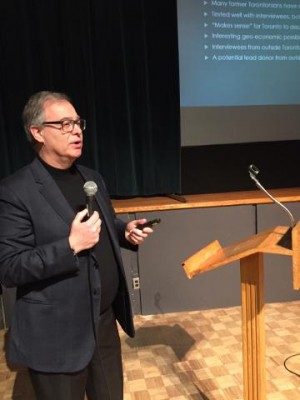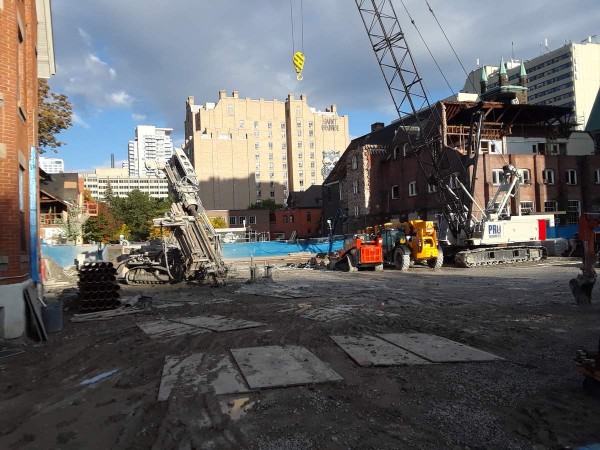Building the new Estonian Centre has reached an important milestone with the completion of a highly positive capital campaign feasibility study conducted by a leading expert.
Mark Gryfe of Gryfe Philanthropic Solutions Inc. was hired by the project steering committee to conduct the study and he presented his findings at the April 4 Estonian Centre Project community information session held at the Estonian House.
Mark has a strong background in conducting capital campaigns, gathered during his 40 years as a fund-raising specialist. He is past president and CEO of both the Baycrest and Mt. Sinai Foundations and has extensive experience in education, social services and health care philanthropy.
The study parameters were developed by Mark in consultation with the heads of the four organizations leading the project (Tartu College, Estonian House, Estonian Foundation of Canada and the Estonian Credit Union).
The purpose of the study was to gauge support, identify potential campaign leadership, identify potential lead donors and gauge the ability to raise funds in Toronto and beyond.
Here are some results from the study, and some thoughts from Mark on the feasibility and keys to success in conducting this important campaign.
Who did you interview for the study?
The respondents were from every 10-year age cohort from 20s to 80s. They included community leaders and volunteers, users and non-users of the Estonian House, young families, Torontonians, North Americans and Europeans as well as dissenting voices, too. All interviews were completely confidential.
Advertisement / Reklaam
Advertisement / Reklaam
How did you conduct the interviews?
We developed a “case for support” document in consultation with the Estonian Centre project steering committee. This draft document was meant to test the overall appeal of the new centre, to test potential fund-raising strategies and to gauge the possibility of financial support. We went over this document with all the people that were interviewed, and they had a chance to review it beforehand.
What was the response to the “case for support”?
It was overwhelmingly positive. People absolutely loved the architecture and they found the concept to be inspirational and uplifting. They could envision the new centre being a hub for Estonian cultural activities and they really liked the fact that it would be located right next to Tartu College, already an established and thriving gathering place. They reiterated how it will be important to ensure financial viability, to have good banquet facilities, good space for social encounters and easy access for those people traveling by car for parking and drop-offs.
Respondents also commented on the strength of the fact that the four organizations leading the project have come together with the common goal of developing the new centre (Tartu College, Estonian House, Estonian Foundation of Canada and the Estonian Credit Union). This was seen as highly positive and fundamental to the success of the project.
Do you think a capital campaign will be successful?
The majority of respondents interviewed said they would give to the new centre.
With a lead donor identified, with a gift of $3 million, securing the $5 million in donor contributions necessary to move forward is most definitely achievable.
What is the most important ingredient for success in a capital campaign?
I would say there are a few – a clear vision of what’s to be accomplished, good leadership and a lead donor willing to step up and lead the way with financial support.
What were your strongest impressions of the Estonian community?
Advertisement / Reklaam
Advertisement / Reklaam
One of the most telling facts in conducting this study was the overriding deep pride people have in their heritage and the deep respect they have for past generations. There is a passion and pride in being Estonian, whether it’s for those who are active participants in the community or those who are “on the fringe” but very much identify as Estonian. This is not the case with all communities!
What are the challenges?
Community characteristics can sometimes affect a capital campaign. Respondents said that Estonians can be slow to change, stubborn, strongly opinionated and frugal. They also cited the fact that the population is being diluted through assimilation and inter-marriage. It will be important to engage our community in ways that resonate with changing demographics and attitudes.
What are the particular characteristics of this project and campaign?
Toronto is blessed with a multicultural diversity that is spectacular, and each community finds its way on how to preserve and share their culture. In Toronto, we are not afraid to show our distinct cultures. Because the city has such a large number of Estonians compared to other locations in North America, it has become a central focus and hub for the culture.
The community is small and tight-knit, fractious in some ways, but passionate and successful in many respects. The four organizations working together is a very healthy way to move forward.
You are very much helped by the fact that other ethnic groups here have strong communities, while contributing to the culture around them. There is great pride in preserving and share this culture. The Estonian community is strong internally and very well represented externally.
Why can naming rights be so key?
Naming rights can include attaching a donor’s name to all and/or parts of the physical structure of the building, such as the great hall, classrooms, café, etc. It’s fair to say that naming rights for the centre is a new concept for the Estonian community, but this is part of moving forward in Canadian culture. When you are asking people to make large gifts, this is what can be involved in the exchange. People making such gifts are obviously proud of what they are supporting, so this is a case of mutual respect. It can very much be a win-win.
Advertisement / Reklaam
Advertisement / Reklaam
In your experience, what are the usual next steps after a feasibility study?
Organizations undertaking a capital campaign will generally start by setting up a leadership structure, building a database, establishing a plan for tax receipts and getting the word out about the campaign. This starts from the top down, typically with a “quiet phase” to get 70 – 80 per cent of the funds in place before the rest of the campaign begins.
Is it a good idea for the new centre have an international focus?
This can add a very strong appeal. People interviewed who are former Torontonians have very deep Estonian roots and it seems to “make sense” to them to have Toronto as a hub, and to have an international aspect. It also makes sense to have Toronto as a geo-business centre, opening up all kinds of possibilities for collaborative work. A potential lead donor from outside Toronto has been identified. The vast majority of donors outside Toronto would contribute to a centre that has an international focus as part of its mandate. Of course, this cannot happen at the expense of local programming – this is of utmost importance.
This shows the community’s steadfastness, resolve and determination. It is a thriving and energetic project that deeply respects what the community’s forefathers and mothers accomplished.


























